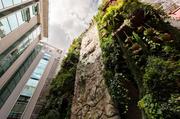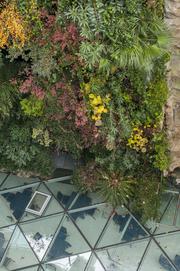1,000 m² Hanging Garden
A small/large ecosystem, Guinness World Record for the largest vertical garden in the world in 2011.
It is a green lung, inside the hotel, composed of more than 2,500 plants.
A work of art whose support and constructive design was solved by architect Felix Gonzalez Vela, with a simple and practical solution.
If the romantic legends are true, it would be the closest thing that exists today to the famous Hanging Gardens of Babylon.
What does this green lung bring to the heart of the city?
It promotes biodiversity. Some birds have also found their home in this ecosystem.
It reduces pollution as it can absorb up to 4 tons of CO2 per year.
It provides thermal and acoustic insulation.
Reduces the temperature between 6 and 8 degrees (effect of 50 air conditioners).
Produces an amount of oxygen equal to that consumed by 200 people a day.
A living and constantly changing project that the landscape technician Manuel Pasquín looks after with great care.
It is so impressive that the TV channel Antena 3 was here to make a report:
4 actions for sustainability and energy saving
We do our bit by implementing these measures:
To absorb CO2
We have the help of the Hanging Garden. A green architecture project that can absorb up to 4 tons of CO2 per year, combining sustainability and decoration.
To heat the water
We have installed 75 m² of thermal collector tubes in the roof area, which provide 34% of the hot water needed by the hotel.
To recycle water
We have a recycling system that collects and treats water from the hotel's showers and toilets to reuse it, among other things, for watering the Hanging Garden.
To reduce energy consumption
The hotel's lighting fixtures are energy efficient, and have a built-in on/off control system to avoid unnecessary electricity consumption.







